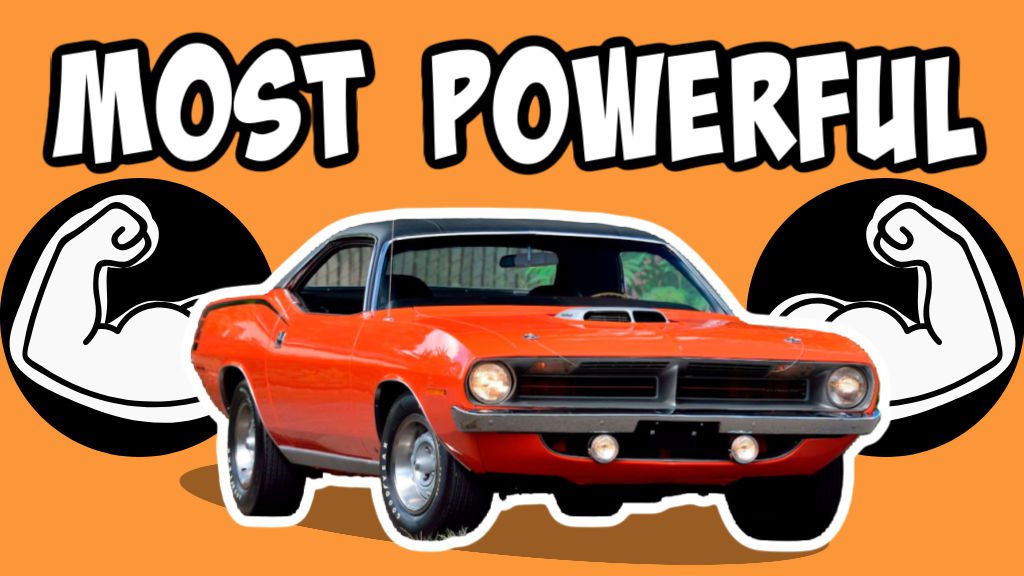
Today we will look at six of the most powerful muscle cars ever produced.
This list includes classic muscle cars with the largest displacement engines, highest advertised horsepower ratings, quickest quarter-mile times, fastest 0-60 times, and more.
Unsurprisingly, these vehicles rank among the fastest muscle cars ever produced. They have some of the largest engines and highest horsepower, leading to their impressive speed during the muscle car era.
Let’s look closer at the most powerful muscle cars ever produced without further ado, shall we?
What are the Most Powerful Muscle Cars Ever Produced?
The most powerful muscle cars include the 1970 Buick GSX 455 Stage 1, 1969 Chevrolet Camaro COPO 427, 1969 Plymouth Road Runner 440-6bbl, 1970 Chevrolet Chevelle SS 454 LS6, 1970 Plymouth Cuda 426 Hemi, and 1970 Ford Torino Cobra 429 SCJ.
These classic vehicles boast impressive features, including the largest displacement engines, the highest advertised horsepower ratings, the quickest quarter-mile times, and the fastest 0-60 times.
Let’s delve into the top six most powerful muscle cars ever produced.
Table of Contents
1970 Buick GSX 455 Stage 1
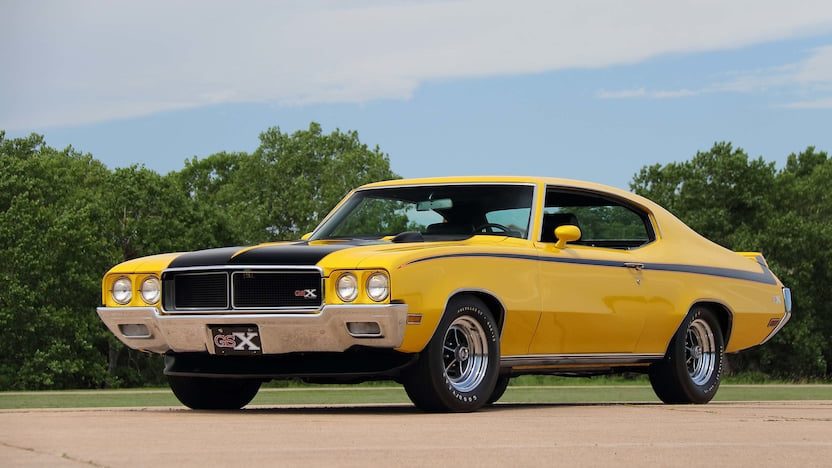
Buick was not originally known for producing the most powerful muscle cars that stood out.
They were often seen as expensive, luxurious muscle cars with subtle paint colors and plenty of creature comforts. However, everything changed when the 1970 Buick GSX Stage 1 option was introduced.
The Buick GSX was created to compete directly with muscle cars like the Pontiac GTO Judge in appearance and performance upgrades.
The 1970 Buick GS Stage 1 base model option did not include any GSX upgrades and was only available in understated paint colors.
The GSX, on the other hand, featured hood stripes, side stripes, a front spoiler, color-keyed sport mirrors, GSX emblems and decals, a rear decklid spoiler, a hood tachometer, and Saturn Yellow or Apollo White paint options.
Every GSX also came equipped with a mandatory black bucket seat interior.
Performance Statistics
| Engine | 455 Stage 1 |
| Horsepower | 360 |
| Transmission | Auto |
| Rear Gears | 3.64 |
| ET | 13.38 |
| MPH | 105.5 |
Quick Facts
- 510-lb.ft. of Torque
- Only 400 Stage 1 GSXs were made in 1970
- The sticker price was $4,479
- The A9 GSX package added $1,100 to the sticker
- Black was the only interior color option
1969 Chevrolet Camaro COPO 427
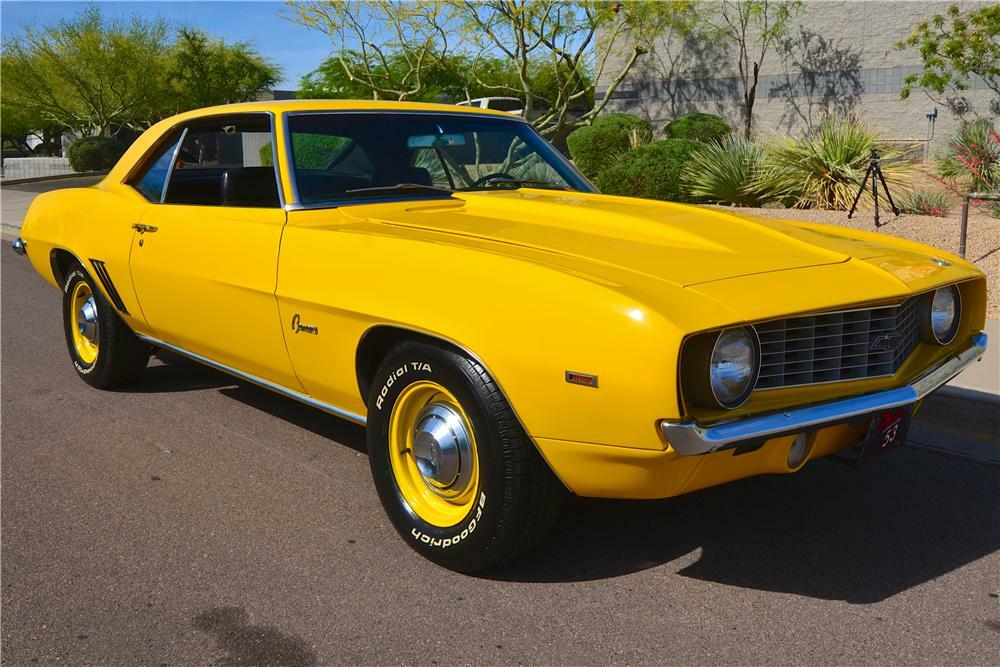
COPO, short for Central Office Production Order, was a dealer ordering system that enabled fleet and municipal buyers to request special paint color options unavailable in regular production vehicles.
It also allowed for the ordering and installing high-performance engine options that were not typically available from the factory.
Chevrolet dealers like Yenko, Nickey, and Baldwin were famous for using the COPO loophole. These high-performance dealers aimed to dominate NHRA Super Stock and NHRA/AHRA Pro Stock racing.
In 1969, Chevrolet produced 69 ZL-1 427 aluminum block Camaros under the 9560 order code, which was impossible in regular production vehicles.
Today, COPO Camaros are among the most valuable muscle cars due to their performance heritage and low production numbers.
With a quarter-mile ET of 13.16 seconds, it was the fourth-fastest muscle car of 1969.
Performance Statistics
| Engine | 427 ZL-1 |
| Horsepower | 430 |
| Transmission | 4-Speed |
| Rear Gears | 4.10 |
| ET | 13.16 |
| MPH | 110.21 |
Quick Facts
- ZL-1 option added $4,260 to the sticker price
- Sticker price was $7,200
- Only 69 were built in 1969
- 450-lb.ft. of torque
- Aluminum block, heads, and intake
- 4.10 posi, cowl induction hood, and front disc brakes
- 0-60MPH in 5.4 seconds
1969 Plymouth Road Runner 440-6bbl
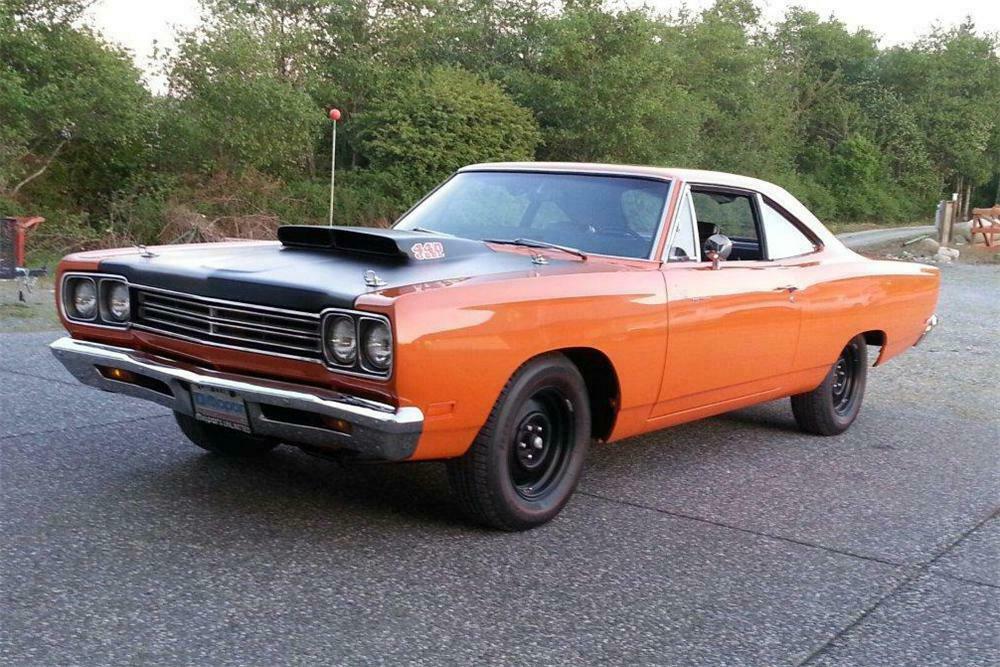
The 1969 Plymouth Road Runner, crowned Motor Trend’s Car of the Year, gained power due to its impressive performance, range of options, stylish looks, and affordable price tag.
Plymouth executives were keen on drag racing and embraced it head-on with the mid-year A12 option.
This option included all the performance modifications a professional drag racer could want, but the difference was that they were available directly from the factory.
A 440 CID V-8 engine? Check! Three 2-barrel carbs? Check! A fiberglass lift-off hood with an open scoop and hood pins? Check!
The A12 option ticked all the boxes for the 1,412 buyers of the 84,420 Road Runners produced in 1969.
It quickly became one of the most powerful muscle cars ever made, coming in second place as both the fastest muscle car ever produced and in the class of 1969, with a quarter-mile ET of 12.91 seconds.
Performance Statistics
| Engine | 440 Six Pack |
| Horsepower | 390 |
| Transmission | 4-Speed |
| Rear Gears | 4.10 |
| ET | 12.91 |
| MPH | 111.8 |
Quick Facts
- 490-lb.ft. of Torque
- M-Code 440 6-bbl added $462.80 to the sticker price
- Base sticker price was $3,083
- Three Holley two-barrel carburetors
- Edelbrock aluminum manifold
- Dana 4.11 rear end
1970 Chevrolet Chevelle SS 454 LS6
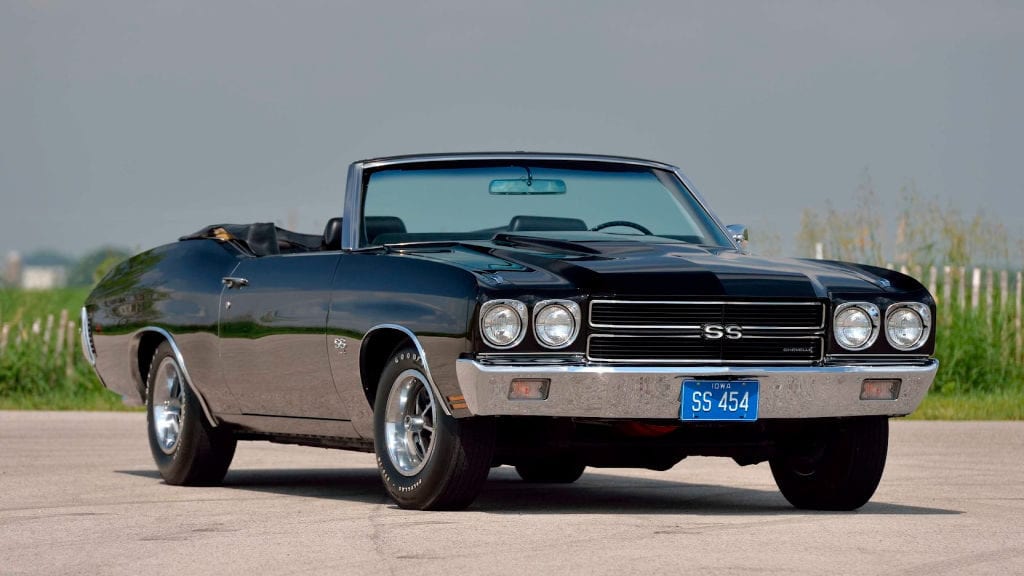
The Chevelle was Chevrolet’s mid-sized family car, but the SuperSport option added a long list of high-performance upgrades to the driveline and suspension, transforming it into a supercar.
The SS option included standard and optional styling upgrades, such as a cowl hood, dual racing stripes, and hood pins.
Engine options included several 396 CID V-8 and 454 CID V-8 options with varying horsepower outputs.
However, the pinnacle option for the 1970 Chevelle SS was the LS6 454 engine which produced an astonishing 450HP.
It was the highest advertised horsepower engine offered during the muscle car era, earning it the top spot on the most powerful muscle cars list.
Unfortunately, it only lasted one year due to spikes in insurance premiums for performance cars and other governmental regulations to improve fuel efficiency.
| Engine | 454 LS6 |
| Horsepower | 450 |
| Transmission | 4-Speed |
| Rear Gears | 3.55 |
| ET | 13.12 |
| MPH | 107.01 |
Quick Facts
- 500-lb.ft. of Torque
- Highest advertised horsepower rating of 450 Horsepower
- 4,475 LS6 Chevelles were produced in 1970
- The base sticker price was $3,486
- LS6 engine added $263.30 to the sticker price
- 0-60MPH in 6.1 seconds
1970 Plymouth Cuda 426 Hemi
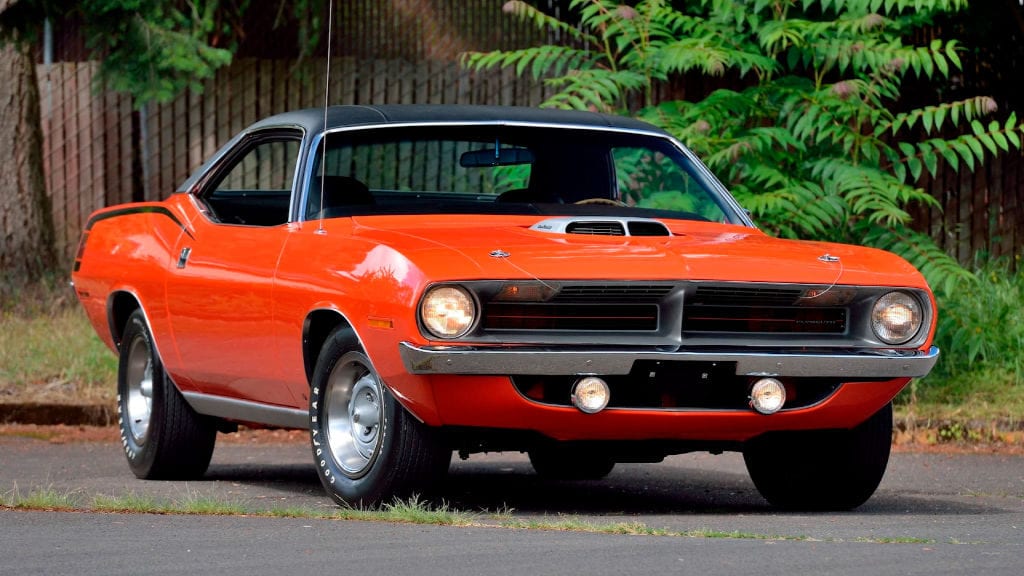
As part of the Rapid Transit System, Plymouth’s new E-Body ‘Cuda immediately became the star of the RTS with its 426 Hemi engine and lighter body style.
The Hemi ‘Cuda boasted dual 4-barrel carbs, a dual quad intake manifold, a heavy-duty radiator, 11-inch drum brakes, a Shaker hood, a 9.75-inch Dana rear end, and F60 tires on 15×7 Rallye wheels.
The Plymouth Cuda also came standard with dual nonfunctional hood scoops, driving lamps on the front valence, a red stripe grille, hood pins, “hockey stripe” decals on the rear quarter panels, and ribbed “fish gill” rocker moldings.
It was truly one of the standout 1970 muscle cars produced that year. Due to their high horsepower and low production numbers, the Hemi’ Cuda hardtops and convertible models have become highly collectible among muscle car collectors.
Performance Statistics
| Engine | 426 Hemi |
| Horsepower | 425 |
| Transmission | 4-speed |
| Rear Gears | 3.54 |
| ET | 13.1 |
| MPH | 107.12 |
Quick Facts
- 490-lb.ft. of Torque
- 666 Hemi Cuda’s were produced in 1970
- Of the 666 produced, only 289 4-Speed Hemi Cuda’s were produced in 1970
- The 426 CID V-8 Hemi engine added $871.45 to the sticker price
- The base sticker price was $3,164
- 0-60MPH in 5.8 seconds
1970 Ford Torino Cobra 429 SCJ

For 1970, the Torino was completely revamped inside and out.
Torinos had always sported an aggressive appearance, but Ford designers took it up a notch by drawing inspiration from supersonic aircraft this year, resulting in a design that looks like it’s moving fast even when standing still.
The ultimate 1970 Ford Torino Cobra was the 429 Super Cobra Jet with the “Drag Pack,” which boasted a 429 CID V-8 high compression engine with 4-bolt mains, a solid lifter cam, an external oil cooler, a free-flowing intake, a Holley 780cfm carburetor, and free-flowing exhaust.
Despite being larger and heavier than a Mustang, it could certainly keep up with them.
The 429 Super Cobra Jet also came with twist-lock hood pins, a blacked-out hood treatment, a blacked-out front grille, and a honeycomb applique that blacked out the rear tail panel.
Performance Statistics
| Engine | 429 SCJ |
| Horsepower | 375 |
| Transmission | Auto |
| Rear Gears | 3.91 |
| ET | 13.63 |
| MPH | 105.9 |
Quick Facts
- 450-lb.ft. of Torque
- 7,675 Torino Cobras were produced in 1970
- Of the 7,675 produced, only 241 were 429 SCJs
- The base sticker price was $3,270
- 429 CID V-8 CJ engine added $229 to the sticker price
- Drag Pack added an additional $155 to the sticker price
- 0-60MPH in 6.3 seconds
Conclusion
The Buick GSX, Chevrolet COPO Camaro, Plymouth Road Runner, Chevrolet Chevelle SS, Plymouth Cuda, and Ford Torino Cobra are some of the most powerful muscle cars ever produced.
These iconic models boast massive engines, high horsepower ratings, quick quarter-mile and 0-60 times, and more, making them a testament to the golden age of muscle cars.
They continue to captivate automotive enthusiasts and symbolize American muscle. These powerful muscle cars have left an indelible mark on the automotive industry and will remain legends for generations to come.
Take Our Poll
There you have 6 of the most powerful muscle cars ever produced. Be sure to subscribe to see more content like this!
Ryan
Ryan has owned muscle cars since 1986 and currently owns a 1972 Dodge Charger Rallye. He combines passion and experience to create engaging content for fellow muscle car enthusiasts. In 2018, he founded Muscle Cars Illustrated, authoring hundreds of articles on tips, history, and trends in the muscle car industry. He attends national car shows, auctions, and museums to stay current with the latest developments in the muscle car industry.